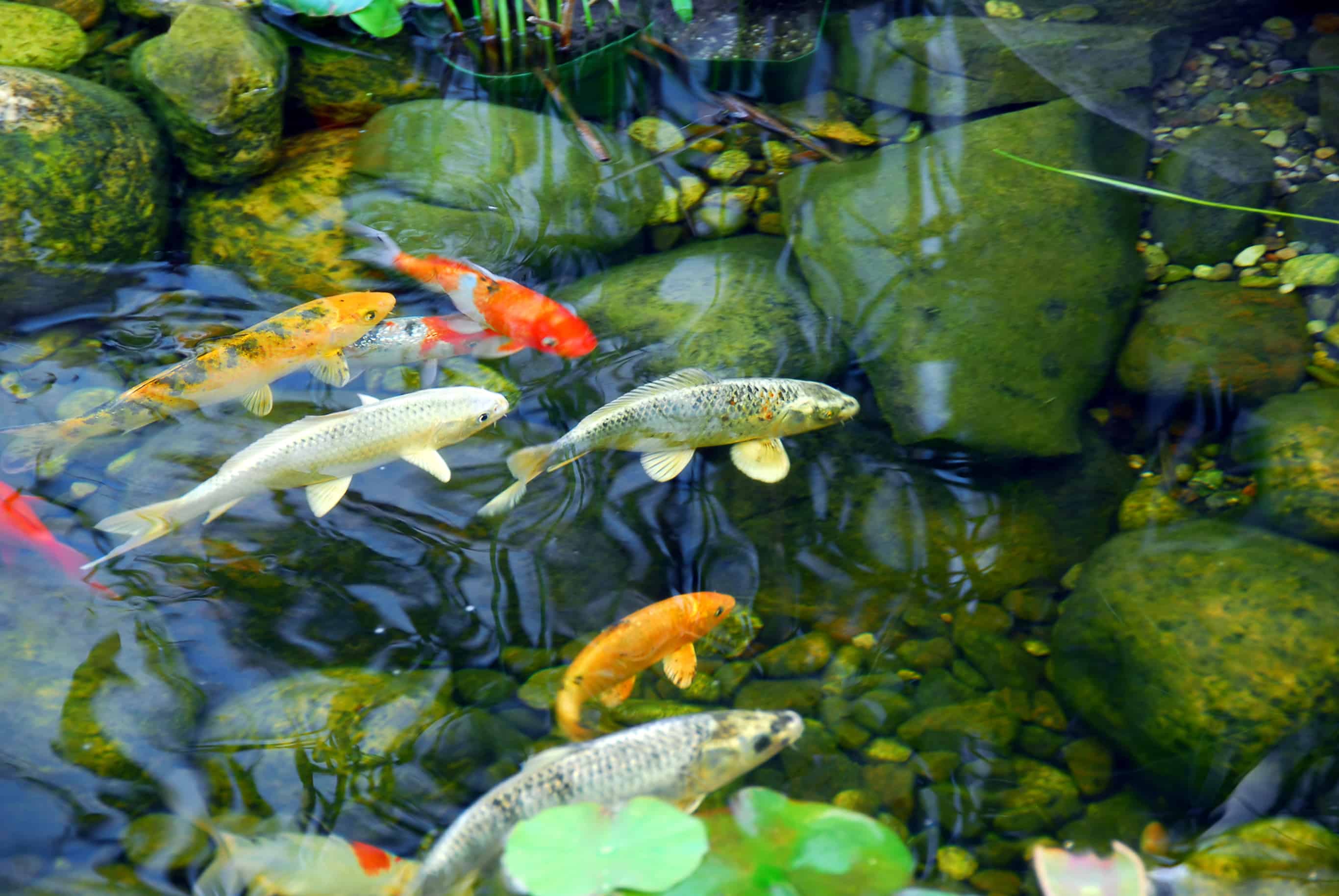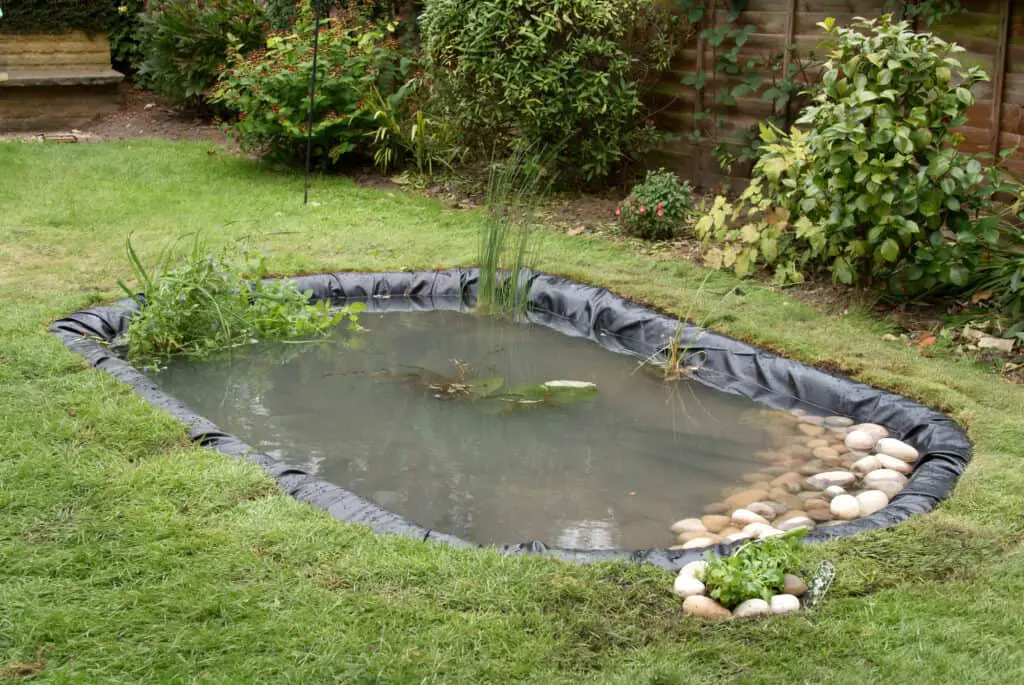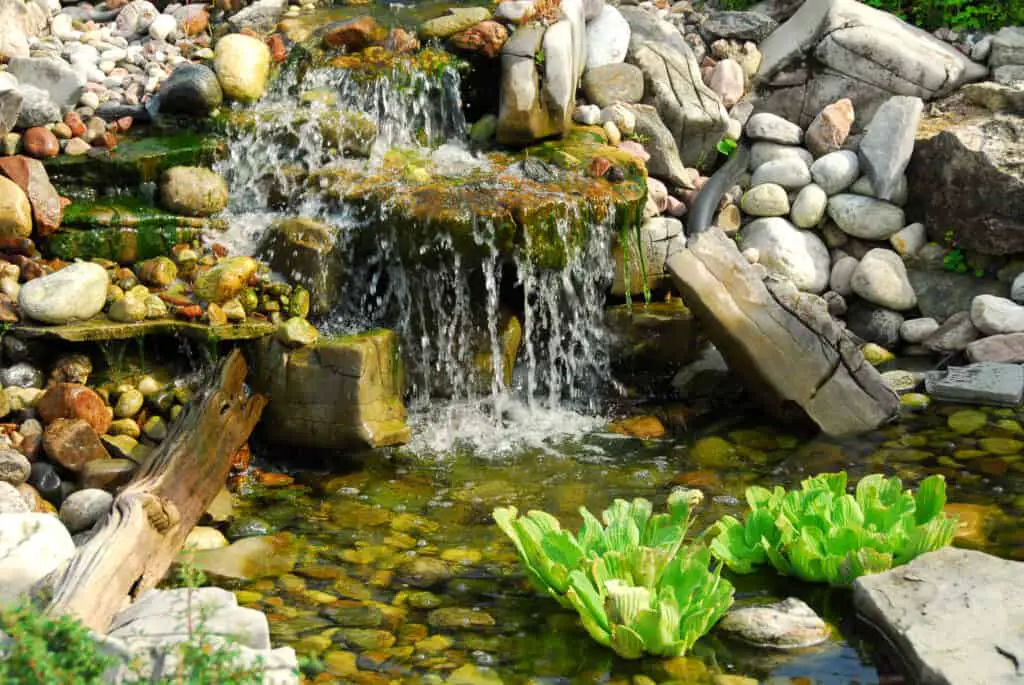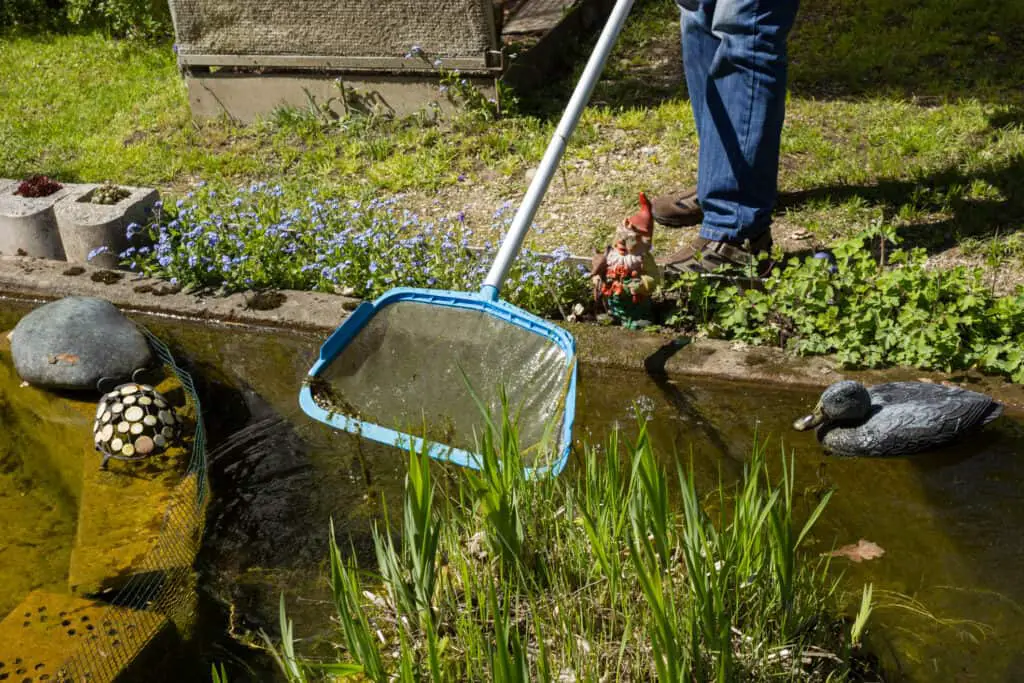
Watching your koi fish swim around in their pond can be a great way to relax and enjoy the tranquility and peacefulness of the moment. To enjoy this moment, you must ensure that you have prepared an ideal space for your beautiful koi fish to live. Deciding whether you should have rocks in your koi pond or not is an important decision you will have to make.
Rocks can benefit any koi pond, offering a surface area for beneficial bacteria to grow, protecting your liners from UV rays, and holding the liner in place. In addition, it makes your pond appear natural, gives aquatic plants’ roots a foothold and prevents slippage if placed on the floor.
It would help to contemplate a few factors before deciding whether rocks suit your unique koi pond. These factors include the size of your pond, the reason you keep koi fish, and your dedication to keeping your pond clean. Once you have considered the factors, you can decide whether rocks suit your pond environment.
Pro Tip: If you’re tired of wasting money and making costly mistakes on the koi-keeping hobby or are thinking about buying koi fish but don’t know where to start, I strongly suggest you check out this ebook. I recently read this ebook, and it contains SO much useful information, such as:
- 3 proven steps to identify koi fish diseases
- WARNING: 3 things you should NEVER do when it comes to caring for koi
- When to seek professional help when it comes to looking after your koi
Should You Have Rocks In Your Koi Pond?

When it comes to whether you should add a few rocks to your koi pond, the answer is a definite yes. Their presence provides a natural appearance to your pond, and they can also create other excellent and helpful pond features, such as waterfalls.
There are several benefits to having rocks in your koi pond, whether you decide to cover the floor of your pond with them, place them around the edges, or place a few in strategic positions. Rocks add aesthetic value to your koi pond, and they can also offer a range of added benefits not only for your pond’s ecosystem but also for your koi fish.
Rocks can have so many uses in a koi pond, so having one or two of them in your pond is almost a given. The real difficulty comes when you decide how many you will have in your pond and why you have chosen to have them. The easiest way for you to answer this question would be to look at how you can utilize rocks in your pond and the pros and cons involved. After that, you can decide how to set up your koi pond rocks.
Rocks In Your Koi Pond: Singular Large Rocks

The most popular use for singular large rocks in a koi pond is to add to the aesthetic value of the pond by placing them in positions to give the pond a more natural feel to it. Even though these rocks make your pond look more appealing to the eye, it doesn’t mean that they are not benefitting your pond in the long run. Let’s look at some of the benefits and disadvantages of using singular large rocks in a koi pond for aesthetic purposes.
Some of the most important benefits include:
- Anchorage for plants: These strategically placed rocks can hold aquatic plants, either as placements for the pots or as a ledge for the plants’ root systems to attach to keep them in place.
- Feature building: You can also use rocks to build features such as waterfalls which aid in water aeration and circulation.
- Hide-outs for your koi: Rocks can create ledges or caves in koi ponds that can provide your koi fish with a hideout or a place they can retreat if predators are around. Ledges and caves are also excellent places for your fish to go if they are looking for a cooler spot when it gets too hot.
- Beneficial bacteria growth: Rocks provide extra surface area for beneficial bacteria to grow. These bacteria aid in the breakdown of fish excrement and other organic detritus.
- Aiding koi curiosity: Koi fish are super curious and will appreciate areas they can investigate. Rocks can help provide these areas in a pond environment.
Some of the disadvantages of having large rocks in a koi pond:
- Upkeep: The main drawback would be keeping them clean. Algae will undoubtedly start to grow on the rocks, which will mean that you will need to clean them.
- Debris accumulation: The underneath of ledges and the inside of caves will require a little more effort to clean than areas out in the open and can provide a place for leaves, twigs, and other detritus to build up.
- Costs: Adding rocks to your pond is an extra cost.
Overall placing large rocks inside your koi pond is an excellent plan, with the benefits far outweighing the cons. As long as you ensure that you keep your rocks as clean as possible and try to remove as much of the floating debris as possible before it can float to the bottom or get stuck underneath them, you should be fine. Your fish will appreciate you providing them with an area to explore, hide out, and improve their ecosystem by providing surface area for beneficial bacteria and microorganism growth.
Rocks In Your Pond: Placing Rocks On The Bottom Of Your Pond

Whether or not to place rocks on the bottom of your koi pond is where many koi owners disagree. Some say that it is an essential and significant benefit to a koi pond to have rocks placed all along the bottom of the pond, and others say that it is a severe drawback to have them on the bottom of a koi pond. It comes down to your personal preference and the time you are happy to spend cleaning and maintaining your koi pond.
There are six key benefits that many koi pond owners and installers put forward as a reason why you should cover your koi ponds bottom in rocks. Let’s take a look at them below.
- Liner protection: Having rocks covering your pond’s liner will protect it from the harsh UV rays of the sun. This protection will prolong your pond’s life, helping to prevent degradation, increasing longevity, and reducing maintenance costs.
- Securing the liner: Rocks help keep the pond liner in place and prevent air bubbles from forming underneath and pushing the liner upwards.
- Recreates natural pond floor environment: Having rocks on the bottom of the pond creates a more natural appearance. In the wild, there would be rocks and gravel on the bottom of ponds and streams and therefore placing them on the bottom of your pond creates a more natural environment for your koi fish.
- Ecosystem enhancer: Placing rocks on the bottom of your pond provides extra surface space for beneficial bacteria and other beneficial microorganisms to flourish and grow. These microorganisms help break down fish excrement and decaying plant matter into usable plant nutrients, which your ponds aquatic plants will consume. The organisms also act as a food source for any crustaceans, aquatic insects, and fish in the pond.
- Sediment trappers: Rocks can act to trap sediment that would otherwise be floating around or accumulating on the bottom of your pond.
- Provides footing stability: The rocks on the bottom of your pond will provide you with stable footing if you need to walk in your pond. Having rocks covering the floor will add extra foundation and prevent you from slipping. Many people need to access their aquatic plants, or they like to interact with their fish, or they may wish to wade through the water for other reasons.
Of course, as with most things, if there are advantages, then there are disadvantages. Let’s peruse some of the disadvantages of having rocks on the bottom of your koi pond.
- Sludge accumulation: Rocks on the bottom of your pond can prevent sludge, fish waste, and other debris from being washed into your bottom drain. This prevention results in waste accumulation on the bottom of your pond instead of it being filtered out and removed. The build-up can cause degradation to your pond’s water over time, creating a thriving environment for harmful parasites and bacteria and a toxic environment for your koi fish.
- Water discoloration: The bottom rocks will often trap leaves which will decompose and release tannins into the water. Although they are not harmful to your koi, these tannins will cause your pond’s water to turn a root beer color.
- Building costs: The cost of adding rocks to the bottom of your koi pond will be relatively high, and you might not want to incorporate this additional sum into your overall expenditure.
- Difficult to clean: Rocks on the bottom of your pond will make cleaning your pond harder and more time-consuming. In many cases, it will also necessitate a more regular cleaning schedule to keep your pond looking good. A bare liner is easier to vacuum using a pond vacuum, and if you have a bottom drain, it is easier for the organic waste to get sucked down the drain and filtered out of your pond.
- Visual effect: If you keep koi fish so that you can appreciate their spectacular colorations, then it might be better for you to keep the bottom of your pond with its bare black liner visible. A black background enables you to get better color visuals.
- Plant growth: Although rocks can provide nice surface space and stability for your aquatic plants’ roots to grow, this can become a problem if you don’t control the plant growth. In some cases, certain plants might become challenging to maintain, growing exponentially and requiring intervention before taking over the pond. Rocks can also provide a surface for string algae to adhere to, making it difficult to remove.
Overall, rocks on the bottom of your koi pond offer some fantastic benefits, but there are also some serious cons. If you choose to lay rocks down on the floor of your pond, you will need to be happy with ensuring that you clean and maintain your koi pond regularly so that the water quality doesn’t deteriorate.
How To Maintain Your Koi Ponds Rocks
Keeping the rocks in your pond semi-clean will make their presence much more viable. There are a few ways to keep your koi pond rocks clean, and if you stay on it, you shouldn’t suffer from too many issues.
- Clean your large rocks using a hosepipe with a spray attachment and spray them down to remove any algae build-up.
- Remove surface debris as often as you can, reducing the amount of organic material that floats to the bottom of the pond.
- Use a pond vacuum to clean up debris and sludge building up around and on the rocks on the bottom of your pond.
- Give your pond a spring clean every one to three years, ensuring that you pay special attention to your rocks. If you have stones on your pond floor, shuffle them around a bit to dislodge any debris and sludge build-up that might be occurring around or underneath them.
- Install a sound filtration system.
- Keep your koi ponds plant population balanced.

Things To Consider Before Installing Rocks In Your Koi Pond
Rocks are such a great feature for any koi pond. Ensuring that you have the correct type and that they will not harm your koi is essential. It would be best to consider several aspects before installing rocks in your koi pond. These include:
- Ensure that you do not use colorful rocks in your koi pond. Often these colored rocks have been dyed with chemicals that will have adverse side effects if placed into your pond.
- When choosing rocks, stones, pebbles, or gravel for your koi ponds, always ensure that you select rounded rocks with no jagged edges that could hurt your fish. You also don’t want to make holes in your pond liner.
- Ensure that you do not use any stones or gravel smaller than 1 – 3 inches, as these smaller stones can get stuck in your filtration system or sucked into your pond vacuum.
- When using gravel, stones, or rocks on the bottom of your pond, try to use a selection of sizes. This variety of sizes will give your pond a more natural look.
- Try not to have a layer of rocks more than 1 – 2 inches deep on the bottom of your pond. Anything deeper than this leaves room for muck and sludge to build up.
- Larger ponds are not suitable for rock bottoms due to their increased susceptibility to muck, sludge, and mud build-ups on their pond bottoms. Smaller ponds are more of a viable option for rocky bottoms.
Conclusion
Rocks are great additions to koi ponds. Some of their benefits include providing extra surface area for beneficial microorganisms to grow, providing hideouts for your koi, aesthetic value, and additional anchorage for your aquatic plants’ roots. Whether you are looking to place a few larger rocks around the edges, creating ledges, caves, or even a waterfall feature, you can’t go wrong with adding a few rocks to your koi pond.
References
https://homeguides.sfgate.com/type-gravel-koi-pond-82526.html
https://homeguides.sfgate.com/better-put-rocks-sand-ornamental-pond-91559.html
https://animals.mom.com/type-gravel-good-koi-pond-10527.html


